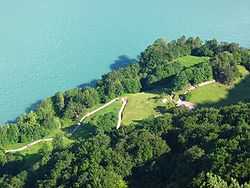Rütli

Rütli (German pronunciation: [ˈryːtli]) or Grütli (French: [ɡʁytli]; Italian: [ˈɡrutli]) is a mountain meadow on Lake Lucerne, in the Seelisberg municipality of the Swiss canton of Uri. Here the legendary oath of the Rütlischwur first occurred and is remembered as the turning-point in the pursuit of independence. Every August 1, on the Swiss National Day, the oath is re-enacted to commemorate the forming of the Old Swiss Confederacy.
Land forming the Rütli meadow was bought by the Schweizerische Gemeinnützige Gesellschaft in 1859 in order to preserve its state and, among other reasons, to prohibit the construction of a hotel at the historical site. This non-profit company turned the Rütli over to the government as an inalienable gift.
On July 25, 1940, General Guisan used the site for his speech, now remembered as the "Rütlirapport", to all commanding officers of the Swiss army in which he outlined the Reduit strategy and his aim never to surrender if invaded (see Switzerland during the World Wars).
Since 1991, Rütli has also been the start of the "Swiss Way" hiking trail created to celebrate the 700th anniversary of Switzerland.
Recent controversy
As is often the case across Switzerland, the August 1 celebrations include speeches; at the Rütli it is common for an eminent personality, such as members of the Swiss Federal Council, to speak. After Neonazis disturbed the speeches 2005, strict controls were enforced in 2006 – only people who registered could get a ticket to the Rütli – but for data privacy reasons, the list could not be reviewed by police to identify known radicals. In 2007 concerns remained (receiving international press attention ) and both the President of the Confederation and the President of the National Council decided to deliver keynote speeches to prevent extremists upstaging the commemorative significance.
See also
| Wikimedia Commons has media related to Rütli. |
- History of Switzerland
- Rütli Commission website (French/German only)
Coordinates: 46°58′10″N 8°35′34″E / 46.969345°N 8.592703°E